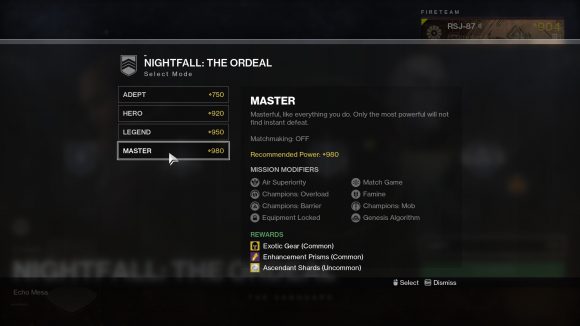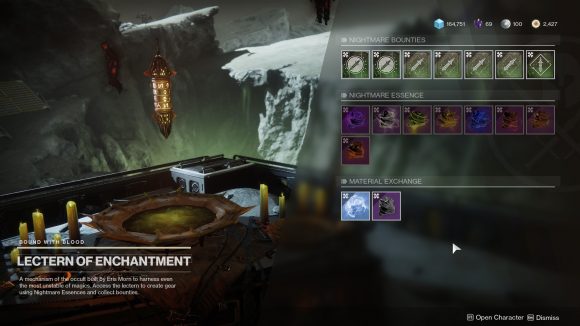Our Verdict
PvP still needs work, and the story is once again more style than substance. However, abundant content elsewhere - including new PvE challenges and a build system with actual depth - means Shadowkeep does what it needs to.
Destiny developer Bungie has said that with Shadowkeep, it’s only just beginning. It’d be a ridiculous thing to say of any other series that had just celebrated its fifth birthday, but then Destiny, for all its influence and popularity, has had a turbulent gestation – one which never really feels like it’s finished, but then welcome to the reality of live games, I guess. It’s bitterly fitting, then, that Shadowkeep’s own launch was marred by server problems even as over two hundred thousand people tried to log in on Steam.
Having now finished the campaign, passed 900 power, and started digging into the overhauled character-building systems such as armour 2.0, the sense that Bungie is still laying the foundations persists. The campaign teases a seismic development in Destiny’s universe, for which we’ll likely be waiting another year or possibly more. Shadowkeep introduces the most promising changes to the endgame yet, especially in PvE, but PvP is still kind of a mess.
The campaign shares much of its structure and many objectives with last year’s Forsaken expansion. There are six ‘proper’ missions, padded out with a new strike, some forced sojourns into the new location, and boss-focused hunts that can be attempted in any order. It’s just that this time we’re exploring the Moon and hunting ‘Nightmares’, rather than Uldren Sov’s Scorn Barons. As revealed in Shadowkeep’s marketing, these are throwbacks to monsters from Destiny history created by a malevolent force beneath the surface of the Moon, which returning queen of melodrama Eris Morn has disturbed.
Your ultimate goal is to forge a creepy new armour set so as to investigate said malevolent force. To do this you need the ‘essence’ from five Nightmare versions of past Destiny bosses, each of which then needs ‘cleansing’ in the open world through various activities, such as killing Hive and completing bounties.

It’s a weaker premise than Forsaken’s quest for vengeance, not a lot actually happens, and frankly it just isn’t as good. It does produce a few cool slices of nostalgia, however: my muscle memory thrums as I steer my Guardian along the familiar twists and turns down to the Summoning Pits to fight Phogoth for possibly the hundredth time, though doing so is snappier on PC. It’s also strangely bittersweet to see these old halls darker and more dilapidated, and to think that my original characters on PlayStation 4 would have some of their own memories to share, validating and chiming with mine. Bungie, please: give PC players a way to sync characters with Destiny 1!
The open-world tasks to ‘cleanse’ the Nightmare essences are sufficiently brief and varied to not outstay their welcome while doing a decent job of getting you out and about on the lunar surface. Destiny veterans will find that a few earthquakes (moonquakes?) and the arrival of a massive fortress, the Scarlet Keep, has changed a lot. The moon was a pretty chill place in Destiny 1 – monochromatic, tranquil, defined by far-reaching grey-white landscapes. Now, huge cracks have split the ground in Archer’s Line and Anchor of Light, leaking sinister green energy and damaging the moonbase and the accelerator. Scarlet-coated Hive and purple-garbed Fallen are everywhere. It feels far more chaotic, colourful, and claustrophobic.
As a fan of the old Moon I’ve found this a little jarring, but if you didn’t play Destiny 1 you won’t know the difference, and setting aside old preferences, there’s a lot to be said for Shadowkeep’s reconstruction. In particular, I’ve had some fun at Sorrow’s Harbour – a new area to the north of the Scarlet Keep – which organically gathered flocks of Guardians to kill lesser Nightmares in the open world together.
Shadowkeep’s chilling new score – all choral chants and nails-on-a-chalkboard strings – can be heard in Sorrow’s Harbour, but really shines in the campaign’s creepiest moments; when you’re swarmed by Thrall in a reprise of the opening stages of the Crota’s End raid, or when the sinister phantoms of dead Guardians flock around you in the depths of the Hellmouth. This is Destiny trying to do horror, and while it’s unfailingly atmospheric – from day one, Destiny has boasted the best art direction, lighting, and grandiose dark sci-fi concepts in any shooter – it’s never actually frightening.
Destiny is structurally incapable of conjuring any sense of real dread, except perhaps in its raids. Elsewhere I’m always too powerful, enemies are always too easy, checkpoints are always too close. Eris can puff up Crota all she likes but Warmind let us kill a worm god in a strike, for goodness’ sake, and it wasn’t even hard. In tabletop parlance, Destiny’s fluff does not match its crunch, and never has.
This tonal disconnect extends to the way the Nightmares are spoken of. Through Eris’s portentous blather Destiny wants us to be petrified of facing these old foes again – Phogoth is the essence of fear, Skolas’s pride led to bloodshed across the system, and blah, blah, blah – but I and anyone who remembers them will get a warm fuzzy feeling, while newcomers will just shrug. But hey, maybe this is the point – there’s always been something tongue-in-cheek about old Eris – and all this doomsaying complements the ominous grandeur of the Moon and the Scarlet Keep to create a campaign that feels fresh for Destiny 2. In both tone and content, then, Shadowkeep is a conscious throwback to Destiny 1, but – thank goodness – one leavened with five years’ hard-earned competence and self-awareness.
After the campaign, Shadowkeep’s most important changes are Nightmare Hunts and Nightfall: The Ordeal. Nightmare Hunts are short missions which are all about the boss at their end – it takes barely five minutes of clearing rooms in the World’s Grave before I’m facing the Nightmare of Crota. As in his old raid, he staggers when hit with a special sword, but is otherwise invulnerable. Each wave of adds includes two Swordbearer Knights which drop said swords, so you can see what you have to do. Nightmare Hunts have timers and scoring, like Nightfall strikes, with more hunts and higher difficulty settings due to roll out over the course of the season.
Nightfall: The Ordeal is a new interpretation of the Nightfall strike, traditionally Destiny’s toughest PvE activity outside of the raid. It has four difficulties, the lowest two of which offer matchmaking, and the highest three of which feature a new hazard: champion enemies. These come in three flavours, each of which can only be killed using mods unlocked by the seasonal artifact. That artifact will drop from the new season rank tree around the end of the campaign, and will level up through XP gained in normal play. You’ll get to unlock those anti-champion mods as it does so, along with a host of others, which at higher tiers offer truly exciting possibilities for theorycrafters alongside the armour 2.0 overhaul (this video from Aztecross Gaming is a great rundown of what’s possible).
It’s still too early to say whether Bungie has been wholly successful in this ambitious overhaul of PvE, but at least tinkering with your build is pretty frictionless. Mods are now infinitely reusable once unlocked and only cost 500 Glimmer to equip. Better mods will take more ‘energy’ in your armour, but upgrading your energy is very affordable until tier seven, by which time you’ll know if you want to commit any further. Perhaps reflecting the reduced importance of raw power, infusion is now very cheap, with all gear, even Exotics, costing only one upgrade module (a common new consumable) to infuse.
There’s a big blind spot, however, and that’s PvP. The reorganisation of the Crucible’s playlists is welcome – especially the dedicated solo queue for Survival, which I know will encourage me to push for some Glory points this season – but after several games it’s clear that substantial and familiar balance problems persist. The Recluse and especially One-Eyed Mask have been, inarguably and egregiously, busted for months now, and it’s baffling that they escaped Bungie’s recent swing of the nerf hammer.
Shadowkeep is like a microcosm of Destiny’s wider trajectory: uneven, but upward in aggregate. Its story is solidly atmospheric with hints of exciting things to come, and while I’ve lost count of how many times I’ve said something like that about Destiny only to be disappointed (cheers, Curse of Osiris), the scale of what’s teased in Shadowkeep does represent a bit of a step up. Besides, thanks to those disappointments, I feel like expectations are pretty low for Destiny’s storytelling, both in my case and across the community. It’s far more important that elsewhere, PvE is in its best condition ever, bursting not only with content but with systems that ask more from you than simply overpowering it.
And so, even if only because it’s finally given Bungie the confidence to claim the mantle of ‘action-RPG’, Shadowkeep is an exciting new chapter in Destiny’s ambitious, turbulent story.



















